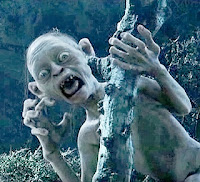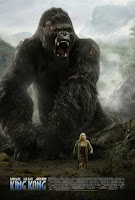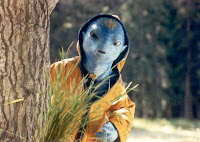Now, as I was posting my VFX story (right below this one), I remembered an interview that I had done with Jim Rygiel, who was the VFX supervisor for the LOTR trilogy. It was my biggest international story at that time. And it was an amazing feeling interacting with Rygiel, as I am a great fan of his work, especially in LOTR. Not to miss out the fact, that he was very candid and would not shy away from calling a spade a spade. He even spoke about the future of Indian VFX. The story was published on CIOL: (http://www.ciol.com/content/news/2006/106030604.asp)
*************************
The Lord of Visual Effects on VFX!
The excitement came back in the movies sometimes in the early eighties, a time when Star Wars, Jaws, E.T., scared, spooked and thrilled audiences worldwide. Steadily computer took its rightful place in movie industry, making the impossible very much possible.
Over the years, the aliens became creepier, the monsters monstrous and extraordinary events became more lifelike. Real and Big are the two words that come to mind when one thinks of computer generated (CG) effects, everything seemed so very real and that too on a big scale. And the Lord of the Rings (LOTR) trilogy epitomizes the progress of visual effects industry, it is a landmark, something that can be compared to Armstrong’s landing on the moon. Jim Rygiel was the visual effects supervisor for the three films directed by Peter Jackson. He was awarded the ‘Best Visual Effects’ Academy Awards (or Oscars) for three consecutive years for LOTR, a record of sorts.
Jim started his career in the 1980 by joining Pacific Electric Pictures, one of the earliest companies to employ computer animation for the advertising and film markets. He has worked as a visual effects supervisor in films like Species, Outbreak, Air Force One, Cliffhanger, Batman Returns, Alien III, Ghost, Anna and the King, 102 Dalmatians and of course the LOTR trilogy. He holds a degree in architecture and a master of fine arts (MFA) degree. He is currently working on films like Click. Jim speaks about how visual effects industry is shaping up, what goes behind the screen (especially in the LOTR) to Shashwat Chaturvedi from Cyber Media News in an email interview. Excerpts.
You are from the fine arts background, how does visual effects fit into your profile? In visual effects, one is constantly trying to make the fantastical as believable as possible, more monsters, more real dragons, etc. Would you refer to visual effects as an art form?
I have always had the concept that anything I do in life is art. The craft and aesthetic of painting a house, cooking a fantastic diner, or even doing ones finances takes special talents and skills that is crafted over time (is like art). Similarly, visual effects is a combination of art, science, mechanics, and even some politics!
The Lord of the Rings trilogy has been heralded as the hallmark movies of the generation, how hard was it to make it a reality? What was the single most arduous task involved?
It was interesting working on Lord of the Rings, when I first approached it I didn’t know what to expect. I knew that I could not possibly do the movie in New Zealand, and planned to take it all back to Los Angeles. However within the first 45 minutes after landing, I was swayed with the technical advancements and filmmaking skills that Peter Jackson had built in New Zealand. The biggest task was to get the entire crew moving forward in production mode.
In LOTR there was a lot of innovative technology that was used, right from motion animation, keyframing to the usage of proprietary software Massive (developed by Weta Digital). Can you briefly describe the various techniques that were used and what were the challenges in implementing them?
Well, we always tried to push the technology, we used virtual reality cameras (based on motion capture) to help us pre-visualize sequences. Motion capture ran for about 3 years straight as we had to capture thousands of motion for all of the different characters, in all of the 3 films. The motion capture was then applied to the Massive software, which drove the many different captured cycles. Our miniature dept ran for approximately 1000 days, shooting all of the various pieces, which would be composited with our live action and CG effects.
You have been supervising visual effects in many Hollywood blockbusters like the Last Action Super Hero, Cliffhanger, Batman Returns, Outbreak, etc. How has your experience with LOTR different from these?
Usually when you work on a film there are 1 or 2 different types of effects, for instance in Batman Returns, we did some digital penguins that performed a few moves, and we also did some digital compositing, but it was basically the same thing. With LOTR almost every shot had something different going on with it. Cave trolls, flying fell beasts, Giant Mumakil elephants, miniatures, live action, CG effects, it had it all!
What was the experience of creating Gollum (Speagol)? Was it completely based on motion-capture of actor Andy Serkis?
Gollum was an evolutionary concept, when we first started thinking about him we had a completely different vision for him. He was a bit more alien looking than his current self. As the shooting progressed Peter Jackson felt he needed someone to play the eyeline character for  Frodo and Samwise so he got Andy Serkis. Andy began to play the eyeline character, and slowly start to recite the lines back during the actor, Andy honed his part and was eventually reciting all of the lines for Gollum, so Peter said hey, lets use Andy’s voice for Gollum since he was doing it so well, as Andy got more into the part, he started hopping around like Gollum, as Peter was editing the film Andy was so amazing as Gollum that Peter asked us to copy his motions as closely as possible because he was perfect for the part. So we did a bit of what we call rotomaton, which is a process where you bend the digital character to match frame by frame to the real character (Andy), we also did some motion capture, and keyframe animation , but I believe the best performance came out through the use of rotomation.
Frodo and Samwise so he got Andy Serkis. Andy began to play the eyeline character, and slowly start to recite the lines back during the actor, Andy honed his part and was eventually reciting all of the lines for Gollum, so Peter said hey, lets use Andy’s voice for Gollum since he was doing it so well, as Andy got more into the part, he started hopping around like Gollum, as Peter was editing the film Andy was so amazing as Gollum that Peter asked us to copy his motions as closely as possible because he was perfect for the part. So we did a bit of what we call rotomaton, which is a process where you bend the digital character to match frame by frame to the real character (Andy), we also did some motion capture, and keyframe animation , but I believe the best performance came out through the use of rotomation.
Of the Cave Troll, Gollum, Treebeard, and Shelob, whom do you find the most fascinating and why?
Well, Treebeard and the Ents gave us some struggle in creating the characters, the animators had to bring forth the age-old grandfatherly wisdom of the giant trees, and yet they had to have great strength, and a bit of whimsy. However it was the Balrog in the first film that was the most challenging and fascinating in terms of technical execution.
To get the feeling that 30-foot waves of fire and smoke were emanating through the character, we shot small flame elements and then used a particle system to create the 30-foot wall of fire that moved with and around the Balrog.
What is the software that you used for LOTR? What was the hardware? What were the kinds of innovations involved, like props, etc.? And how big was a challenge to supervise a big and diverse team of visual effects artists?
We used Maya software for our animation, particle systems, and general scene setup. Shake was primarily used for compositing the elements together, we had farms of Intels and IBMs (about 6000 on the last film) for our rendering power, and we used Renderman for the final rendering of the CG effects. The Artists themselves were fantastic, there was a great diversity from around the world. On the last film, I supervised 450 global artists (we called ourselves digital migrant workers) as many of them went from job to job around the globe. Language was a barrier but we all spoke a global CG language (Maya, Shake).
What is your views about the trouble with audience habituation, people are becoming so accustomed to special effects in films like War of the Worlds, Jurassic Park, King Kong, etc. that the effect-wizards are locked in an upward spiral of an endless special-effects arms race, with demands for bigger explosions, uglier villains, and ever expanding battle scenes?
From a job standpoint, I love it as it keeps me employed. But in my book story is always the king! In all too many films we have seen amazing crazy mind bending effects that have either gotten lost or suffered because of the lack of story. I love working on mega blockbusters, as well as the small intimate films, in both types of films my job is the same that is to help the director tell his story.
You have been in the industry for over two decades now, where do you think is the special effects/animation industry headed? What is the road ahead so as to say?
The nice thing about digital filmmaking is that, it is limitless. Anything that can be thought, can be achieved. There will be new venues, audience participation films, virtual reality films, and in the future who knows maybe even holographic films. Things are definitely getting more exciting in the visual effects world.

Tell us about your interactions with Peter Jackson, how was it working with him?
Well its amazing when you are working with a genius, Peter is as nice in person as he is in interviews, he absolutely knows what he wants and lets you know exactly what that is, there is no beating around the bush. He is very attentive to your feedback as an individual. It was truly amazing to work with a man like him.
Which movie has impressed you the most (special effects) and have you seen a film where special effects are too overwhelming and in the end losing the plot?
I guess I would have to say 2001, even though it was very simplistic in its approach, (It was basically flying matte paintings). It was earth shattering at the time in terms of its look, we were brought up on bad 50’s sci-fi films and then along comes a movie that actually showed us what living in space is going to be like, it was bringing the mundane-ness of everyday life into space. For instance a Pan-Am spaceship bringing you up to a Howard Johnsons Hotel in space and the AT&T space phone.
The Matrix 2 and 3 became overwhelming for me the effects were fantastic but it became too much of a good thing. I think it was a problem again with the story vs. the effects.
Have you ever seen an Indian movie, if yes, what are you views on the same?
I have never been to India but would love to come over there sometime. I occasionally turn on the Indian channel on television , and watch the spectacle of the Indian film, I have no idea what is going on, but it is quite beautiful to watch all of the dances and costumes.
Indian is renowned for its IT prowess globally; do you think India can ever replicate the kind of work done by Weta in New Zealand?
Yes absolutely! However the machines are nothing, so that makes all of the IT power in the world worthless, unless you can get good artists to run those machines. The aesthetic needs to be addressed, much like the difference in aesthetics between the Indian film and the Hollywood blockbuster. However, I feel that the world is getting smaller and I am actually doing some work in Mumbai, with a company called Frame Flow, I used the same Indian producer for some work on Lord of the Rings.



